Motorcycle Hand Signals
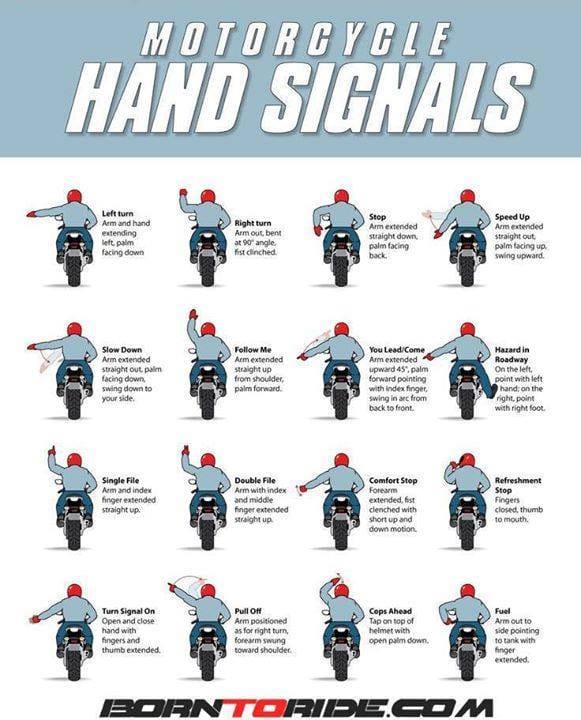
If you Google this topic, you will get quite a number of hits from a wide selection of sites. So why write another article about hand signals if there are already many sites spelling it out for you. Because so many folks STILL are not using hand signals when needed or they are using them incorrectly.
Riding a motorcycle, whether solo or in a group, requires effective communication to ensure safety and coordination on the road. While verbal communication is sometimes NOT an option due to the noise of the wind and the engine, hand signals play a vital role in relaying messages between riders or even to other motorists. These universally recognized gestures help motorcyclists alert each other to upcoming turns, stops, hazards, or changes in speed.
Here’s a basic guide to the most important motorcycle hand signals every rider should know:
Left Turn Signal
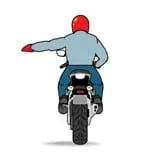
Extend your left arm straight out with your palm facing down.
As with ALL hand signals, it’s important to signal early enough so other riders or motorists can anticipate the maneuver.
Right Turn Signal
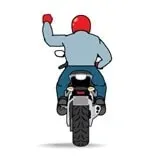
Extend your left arm and bend it upwards at a 90-degree angle, with your palm facing forward.
Some riders prefer to use their right hand for this, but it's generally safer to keep the right hand on the throttle.
Stop Signal
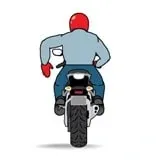
Extend your left arm downwards, with the palm facing backward.
As many of us know, we do not always use our brakes to slow down before coming to a stop. We use engine braking. This hand signal warns riders behind you that you are slowing down or coming to a stop. This signal helps avoid sudden braking, which can be hazardous in a group ride. When in a group, I try to lightly tough my foot brake as well giving even more notification that we are slowing.
Speed Up Signal
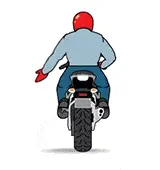
Extend your left arm with your palm facing up, then swing your arm in an upward motion.
I do not think I have ever seen this used. Usually you can hear the bikes as they speed up but this signal can be used by the lead rider in a group to signal that it’s time to increase speed.
Slow Down Signal
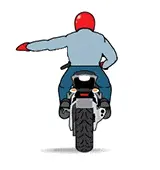
Extend your left arm with your palm facing down, then swing your arm down towards the ground.
I have seen this used occasionally. What I have seen is many folks use a variation of the Stop hand signal waving their hand in a back and forth motion. This hand motion signals that the group should reduce speed, often used when approaching slower traffic, intersections, or hazards.
Follow Me Signal
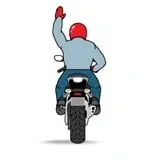
Extend your left arm straight up with your palm facing forward.
Indicates that the rider intends to lead and others should follow. I have not seen this used but many times our groups of riders are somewhat small (less than 8). I can see in a very large group how this may use more frequently especially if the routes becomes a bit confusing.
You Lead Signal
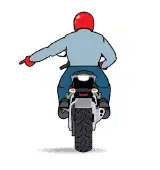
Extend your left arm straight out pointing directly to another bike and then point forward.
Indicates that the rider that was pointed to should take the lead.
Hazard Signal (Left or Right Side)
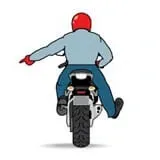
To signal a hazard on the left, extend your left arm straight down with your palm open and pointing toward the ground (it is also common for a rider to extend their left foot outward). For a hazard on the right, extend your right leg outward.
Personally I disagree with using your left hand to signal a hazard. There are SO many hand signals, it is easy to misinterpret the hazard for something else. Remember, you probably only had a few seconds to recognize the hand signal AND make sure you avoid the hazard. I find it much easier to use your left foot.
This signal is the one I use the most. Alerts other riders to potential road hazards such as debris, potholes, or animals.
Single File Formation
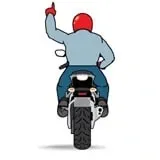
Raise your left hand with your index finger pointing upward.
Instructs the group to ride in a single-file line, which is often necessary on narrow roads or in heavy traffic.
Double File Formation
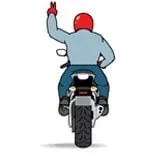
Raise your left hand with two fingers pointing upward.
Signals the group to ride in a staggered formation, which is the safest riding formation for groups. It provides adequate space for each rider while maximizing visibility.
Comfort/Stretch Break Signal
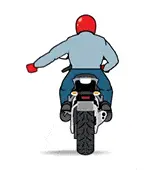
Use a closed fist using short up and down motions.
Indicates the need for a comfort break or a stretch break. I have not seen this one used either. There is another signal for fuel and another for a drink so I am not really sure how applicable this one is at least to me. Maybe it is very useful during long rides but honestly, every long ride I have taken, I have been by myself OR with another person with an intercom.
Turn Signal (blinkers) Off Reminder
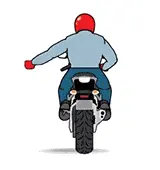
Open and close your left hand, mimicking a blinking motion.
Used to remind a rider that they’ve left their turn signal on after completing a turn. This helps maintain clarity in communication and avoids confusion.
Pull Over
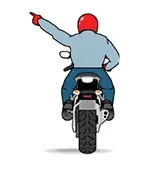
Raise you left arm pointing a finger in the air and motion it to the right side.
Lets other riders know that we need to pull over. This could be a rest area, road exit, or just the side of the road. This typically is used when there is some type of issue.
Cops Ahead
Tap the top of your helmet with your left hand moving it up and down.
Warns fellow riders that there are law enforcement officers nearby, potentially enforcing traffic rules or conducting speed checks.
Tips for Effective Hand Signal Use
- Signal Early: Give ample time for others to see and react to your signals.
- Make Sure You’re Seen: Ensure that your hand signals are clear and visible to the riders behind you. This may require adjusting your body position.
- Practice Makes Perfect: Get comfortable with each signal so you can perform them smoothly and confidently while riding.
- Communicate Within the Group: Establish a common understanding of these signals before group rides, especially if riding with new riders.
The Importance of Hand Signals in Group Rides
When riding in a group, the lead rider is responsible for signaling to the other riders. Each subsequent rider should then repeat the signal to ensure it reaches the tail of the group. This relay method helps ensure that even riders at the back of a larger group can be prepared for upcoming changes.
Conclusion
Motorcycle hand signals are an essential part of riding safely and effectively. Knowing how and when to use them can significantly enhance communication between riders, improving coordination, and preventing accidents. Whether you’re riding solo or as part of a group, mastering these gestures is an important skill for every motorcyclist. Stay safe, ride smart, and keep the signals clear and consistent!
